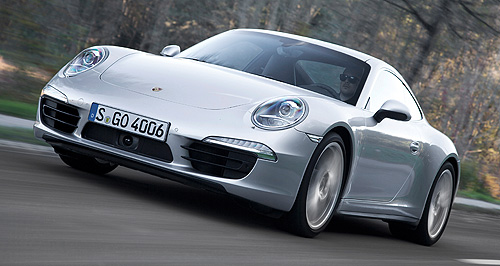News - Porsche - 911 - Carerra SPorsche pledges to let fun rule its 911Still fun: Porsche’s engineers kept a close eye on the driving feel of the Carrera 4 to make sure safety technologies did not ruin the seat-of-the-pants experience. Fun factor high on the agenda as Porsche treads warily on safety ‘nanny’ technology2 Nov 2012 By RON HAMMERTON in AUSTRIA PORSCHE engineers and product planning experts admit they are in a constant state of debate about where to draw the line at myriad new safety technologies that threaten to tame the fun out of the iconic 911 sportscar as it approaches its 50th anniversary next year. The company’s product line director for 911, August Achleitner, said at this week’s 911 Carrera 4 global media launch in Austria that Porsche was never first to market with such technologies, because the company wanted to fully evaluate them to ensure they did not ruin the Porsche driving experience. But he said that while the new all-wheel-drive Carrera 4 was the safest 911 ever produced, it was also the most fun. “We have to ask ourselves ‘do we need these systems in 911’,” he said. “But we make sure it never gets boring in a 911, and it is always fun to drive.” Porsche says the new Carrera 4 – with the latest version of the company’s torque-splitting all-wheel drive system and a range of so-called ‘nanny’ safety technologies – still leaves the driver in charge with a feel of full control.  From top: Porsche 911 Carrera 4 coupe Carrera 4 cabriolet. From top: Porsche 911 Carrera 4 coupe Carrera 4 cabriolet.“The new 911 is easier to drive, but not too easy to drive,” a spokesman told the Carrera 4 press conference, adding: “We have taken it to a higher level – that’s it.” Among the new safety technologies debuting as options in the 911 Carrera 4 are adaptive cruise control with autonomous braking – features that are already on offer as standard equipment on even the most basic cars, such as the Volkswagen Up. Most of the safety emphasis has been on the chassis and drivetrain controls, including new technology to take some of the nervousness out of the torque-splitting between the front and rear axles. Mr Achleitner told GoAuto that changes down the generations of 911 had rid the car of its reputation for awkward handling. He said the car was now better balanced, with about 62 per cent of the weight over the rear wheels where most traction was needed in a high-powered vehicle. He said he believed the ideal would be about 55 per cent over the rear axle for a predominantly rear-driving car, not 50/50 as claimed by some car companies. Mr Achleitner said the very existence of the rear-engine layout of the 911 had been debated within Porsche 30 years ago, but it had not only survived, but thrived. He said he could see a long future for the 911 and its unique flat-six engine mounted under the rear of the car. However, he is not so sure about the manual transmission, which is out-sold nine to one by the slick PDK dual-clutch automatic in global sales. He said he personally favoured the manual, but could see why the PDK dominated. Mr Achleiter’s team are now putting the final touches to the two 911 flagship models, the Turbo and GT3, which are expected to go on sale in Europe next year before heading Down Under late in 2013. Because the Geneva motor show usually is favoured for sports car releases by European manufacturers, at least one of these is expected to make its formal debut there in March. The year 2013 will mark the golden anniversary for the 911, with Porsche preparing a special book with 911 pages of history and photographs to mark the event. In Australia, the 911 range will expand in February or March with deliveries on the new Carrera 4 Coupe and Cabriolet, and then the GT3 and Turbo either late in the year or early 2014.  Read more |
Click to sharePorsche articlesResearch Porsche 911 pricing
Motor industry news |
















Facebook Twitter Instagram